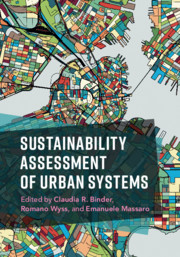Book contents
- Sustainability Assessment of Urban Systems
- Sustainability Assessment of Urban Systems
- Copyright page
- Contents
- Preface
- Acknowledgments
- Contributors
- General Introduction
- Part I Theoretical Background
- 1 Sustainability Assessment: Introduction and Framework
- 2 Systems Science and Sustainability Assessment
- 3 How Values Play into Sustainability Assessments: Challenges and a Possible Way Forward
- 4 The Politics of Participatory Sustainability Assessments: An Analysis of Power
- 5 A Concept for Sustainability Transition Assessment (STA): A Dynamic Systems Perspective Informed by Resilience Thinking
- Part II Integrative Approaches for Sustainability Assessment
- Part III Perspectives on Urban Sustainability
- Part IV Focal Points of Urban Sustainability
- Index
- References
1 - Sustainability Assessment: Introduction and Framework
from Part I - Theoretical Background
Published online by Cambridge University Press: 27 March 2020
- Sustainability Assessment of Urban Systems
- Sustainability Assessment of Urban Systems
- Copyright page
- Contents
- Preface
- Acknowledgments
- Contributors
- General Introduction
- Part I Theoretical Background
- 1 Sustainability Assessment: Introduction and Framework
- 2 Systems Science and Sustainability Assessment
- 3 How Values Play into Sustainability Assessments: Challenges and a Possible Way Forward
- 4 The Politics of Participatory Sustainability Assessments: An Analysis of Power
- 5 A Concept for Sustainability Transition Assessment (STA): A Dynamic Systems Perspective Informed by Resilience Thinking
- Part II Integrative Approaches for Sustainability Assessment
- Part III Perspectives on Urban Sustainability
- Part IV Focal Points of Urban Sustainability
- Index
- References
Summary
Sustainability assessment aims to operationalise the popular but ambiguous concept of sustainability in the analysis of concrete problems and in decision-making situations. However, instead of being a strictly defined methodology, sustainability assessment is a field of science and practice that covers a range of possible tools and processes. To give an introduction to the topic, in this chapter we first place sustainability assessment in its societal and scientific context, and then proceed to discuss its definitions, characteristics, and current limitations based on a review of state-of-the-art literature. Furthermore, we propose a general framework of the dimensions of sustainability assessment, which makes a distinction between the assessment process itself and the broader contextual factors that influence the design of individual applications of sustainability assessment. The framework is meant to identify in a comprehensive manner the concepts, questions, and choices that a thorough design of a sustainability assessment will encounter.
- Type
- Chapter
- Information
- Sustainability Assessment of Urban Systems , pp. 7 - 29Publisher: Cambridge University PressPrint publication year: 2020



